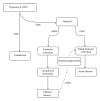Understanding delayed T-cell priming, lung recruitment, and airway luminal T-cell responses in host defense against pulmonary tuberculosis
- PMID: 22545059
- PMCID: PMC3321538
- DOI: 10.1155/2012/628293
Understanding delayed T-cell priming, lung recruitment, and airway luminal T-cell responses in host defense against pulmonary tuberculosis
Abstract
Mycobacterium tuberculosis (M.tb), the causative bacterium of pulmonary tuberculosis (TB), is a serious global health concern. Central to M.tb effective immune avoidance is its ability to modulate the early innate inflammatory response and prevent the establishment of adaptive T-cell immunity for nearly three weeks. When compared with other intracellular bacterial lung pathogens, such as Legionella pneumophila, or even closely related mycobacterial species such as M. smegmatis, this delay is astonishing. Customarily, the alveolar macrophage (AM) acts as a sentinel, detecting and alerting surrounding cells to the presence of an invader. However, in the case of M.tb, this may be impaired, thus delaying the recruitment of antigen-presenting cells (APCs) to the lung. Upon uptake by APC populations, M.tb is able to subvert and delay the processing of antigen, MHC class II loading, and the priming of effector T cell populations. This delay ultimately results in the deferred recruitment of effector T cells to not only the lung interstitium but also the airway lumen. Therefore, it is of upmost importance to dissect the mechanisms that contribute to the delayed onset of immune responses following M.tb infection. Such knowledge will help design the most effective vaccination strategies against pulmonary TB.
Figures


Similar articles
-
Understanding and overcoming the barriers to T cell-mediated immunity against tuberculosis.Semin Immunol. 2014 Dec;26(6):578-87. doi: 10.1016/j.smim.2014.10.003. Epub 2014 Oct 28. Semin Immunol. 2014. PMID: 25453230 Free PMC article. Review.
-
Orchestration of pulmonary T cell immunity during Mycobacterium tuberculosis infection: immunity interruptus.Semin Immunol. 2014 Dec;26(6):559-77. doi: 10.1016/j.smim.2014.09.003. Epub 2014 Oct 11. Semin Immunol. 2014. PMID: 25311810 Free PMC article. Review.
-
Crosstalk between Mycobacterium tuberculosis and the host cell.Semin Immunol. 2014 Dec;26(6):486-96. doi: 10.1016/j.smim.2014.09.002. Epub 2014 Oct 7. Semin Immunol. 2014. PMID: 25303934 Free PMC article. Review.
-
Macrophage immunoregulatory pathways in tuberculosis.Semin Immunol. 2014 Dec;26(6):471-85. doi: 10.1016/j.smim.2014.09.010. Epub 2014 Oct 30. Semin Immunol. 2014. PMID: 25453226 Free PMC article. Review.
-
Natural and trained innate immunity against Mycobacterium tuberculosis.Immunobiology. 2020 May;225(3):151951. doi: 10.1016/j.imbio.2020.151951. Epub 2020 Apr 27. Immunobiology. 2020. PMID: 32423788 Review.
Cited by
-
Evaluation of the Immunogenicity of Mycobacterium bovis BCG Delivered by Aerosol to the Lungs of Macaques.Clin Vaccine Immunol. 2015 Sep;22(9):992-1003. doi: 10.1128/CVI.00289-15. Epub 2015 Jun 24. Clin Vaccine Immunol. 2015. PMID: 26108288 Free PMC article.
-
Toll-Like Receptor-1 Single-Nucleotide Polymorphism 1805T/G Is Associated With Predisposition to Multibacillary Tuberculosis.Front Immunol. 2018 Jun 25;9:1455. doi: 10.3389/fimmu.2018.01455. eCollection 2018. Front Immunol. 2018. PMID: 29988507 Free PMC article.
-
Dual neutrophil subsets exacerbate or suppress inflammation in tuberculosis via IL-1β or PD-L1.Life Sci Alliance. 2024 May 21;7(7):e202402623. doi: 10.26508/lsa.202402623. Print 2024 Jul. Life Sci Alliance. 2024. PMID: 38803236 Free PMC article.
-
Impairments of Antigen-Presenting Cells in Pulmonary Tuberculosis.J Immunol Res. 2015;2015:793292. doi: 10.1155/2015/793292. Epub 2015 Aug 3. J Immunol Res. 2015. PMID: 26339660 Free PMC article.
-
Innate Immunity Holding the Flanks until Reinforced by Adaptive Immunity against Mycobacterium tuberculosis Infection.Front Microbiol. 2016 Mar 14;7:328. doi: 10.3389/fmicb.2016.00328. eCollection 2016. Front Microbiol. 2016. PMID: 27014247 Free PMC article. Review.
References
-
- Global tuberculosis control: key findings from the December 2009 WHO report. The Weekly Epidemiological Record. 2009;85:69–80. - PubMed
-
- Co DO, Hogan LH, Kim SI, Sandor M. Mycobacterial Granulomas: keys to a long-lasting host-pathogen relationship. Clinical Immunology. 2004;113(2):130–136. - PubMed
-
- Ehlers S. Immunity to tuberculosis: a delicate balance between protection and pathology. FEMS Immunology and Medical Microbiology. 1999;23(2):149–158. - PubMed
-
- Ferebee SH. Controlled chemoprophylaxis trials in tuberculosis. A general review. Bibliotheca tuberculosea. 1970;26:28–106. - PubMed
Publication types
MeSH terms
Substances
Grants and funding
LinkOut - more resources
Full Text Sources
Research Materials
Miscellaneous

